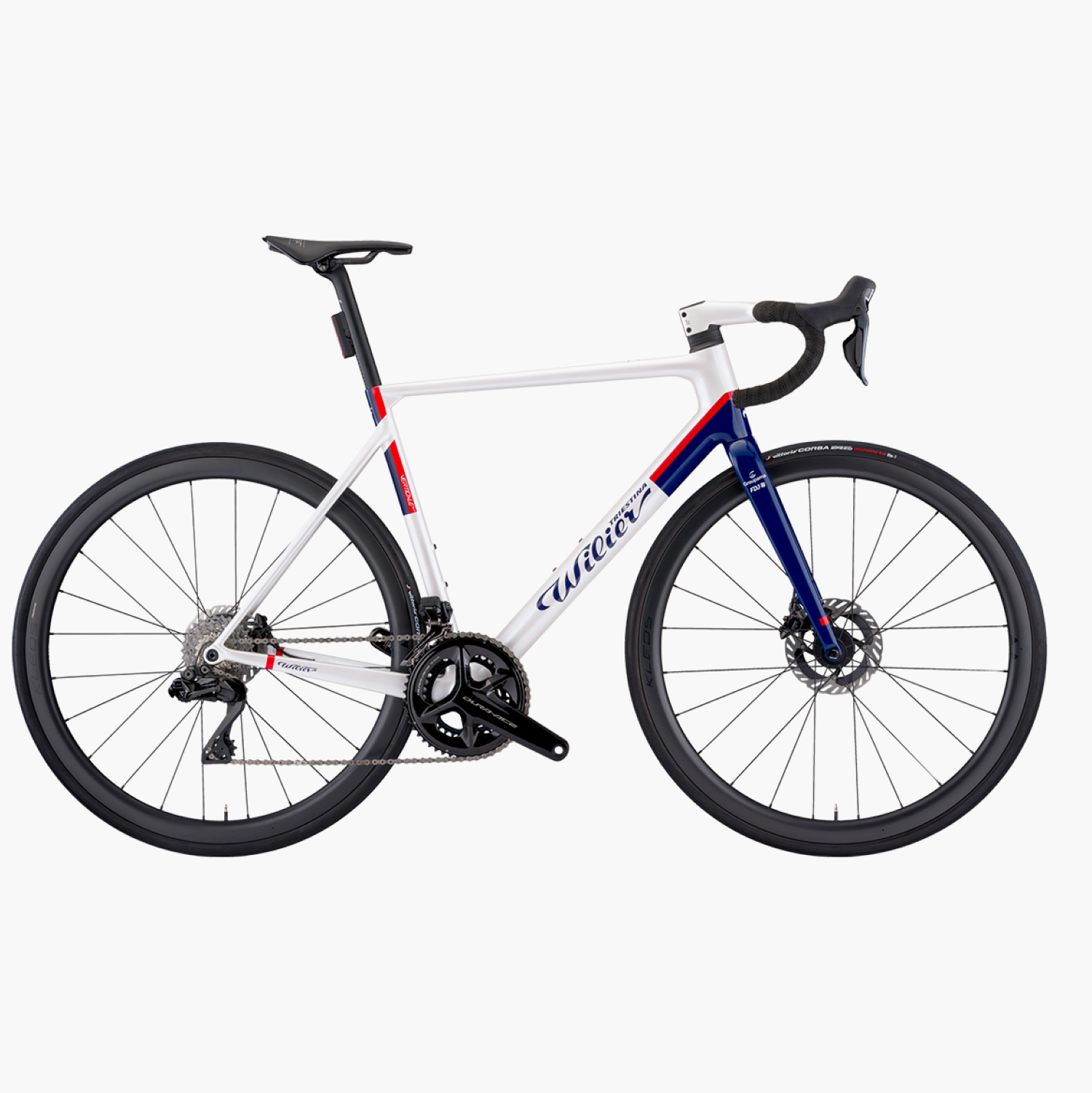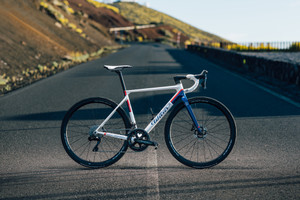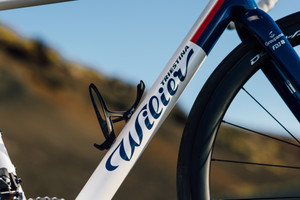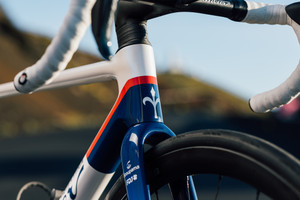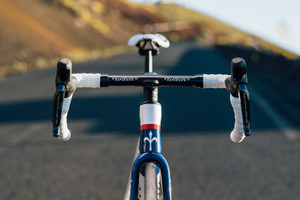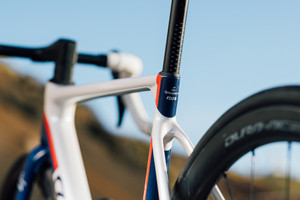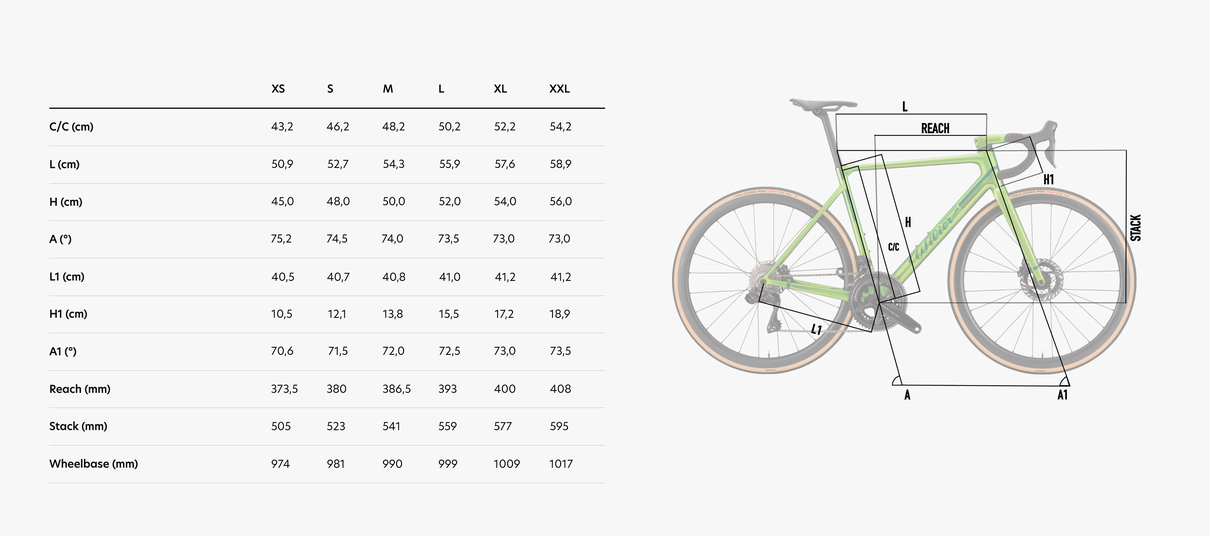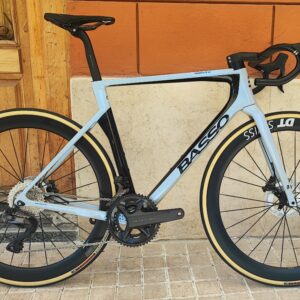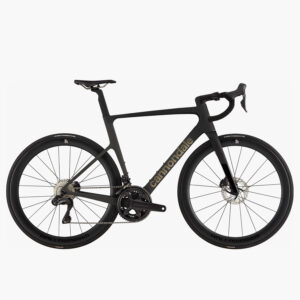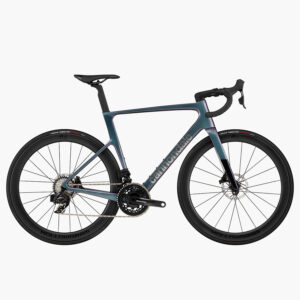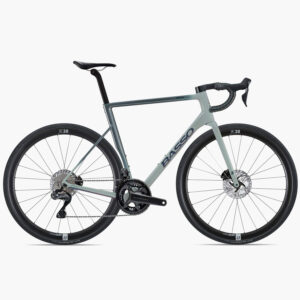Wilier Verticale SLR Groupama FDJ (Shimano Dura Ace di2 R9270 + Powermeter)
Our lightest ever bike
Lightness must be controlled. Making a lightweight frame is relatively simple, but making
a lightweight one with top-notch performance and riding qualities requires a strong
legacy.
The Verticale SLR is the best example of what we have been, and of what we do best: a
racing bike that has improved weight over the Wilier 0 SLR by almost 10%. Lighter weight,
greater responsiveness, improved performance levels.
The Verticale SLR is today the best calling card for Wilier, the new generation of the best
Italian bicycle manufacturers.
Outstanding carbon
When we address the frame of a climbing bike, the first aspect we need to consider is the
raw material used. Using the highest quality composite materials is the starting point to
give rise to a project that focuses fully on top-level performance.
It’s not just the material that makes a difference, but it is certainly the first major piece of
the puzzle on which to base the remainder of the design. We know that when we talk about
composite material, we are not just talking about a certain combination of resin and
reinforcement, but about a variety of materials, made up of different types of carbon fibres.
For the Verticale SLR, we specifically used 3 types of fibres produced by Toray, a Japanese
multinational and leader in the carbon fibre market, especially T800, T1100, and
M46JB.The first two are distinguished by extremely high tensile strength, whereas the
latter is high modulus, which gives the frame superior torsional stiffness.The selected
carbon fibres are impregnated with special epoxy resins and prepared for use in preimpregnated
rolls referred to as pre-preg, which are subsequently cut into more than 400
outlines with various types of shape and reinforcement orientations.
Using novel manufacturing technologies allows the insertion of pre-shaped materials into
the mould, this process allows for the frame to be accurately cured. This technical term
refers to the transformation process which leads to the optimal hardening of the resin to
achieve the best possible performance.
Specifically, the major news that distinguish the innovative technological process behind
the Verticale SLR is the new “ACTIVE MOULDING” system, characterised by the use of
special foamed polymer counter moulds which adapt to the materials during the curing
process, whereby the materials consolidate and harden.
WILIER TRIESTINA | VERTICALE SLR, PRESS RELEASE
The frame
New seatpost clamp system: We fine-tuned the fastening device which no longer fastens
from the top but diagonally from the bottom. This tightening system has allowed us to
lighten the weight at that point of the frame with respect to the 0 SLR.
New derailleur coupling: Another major and fundamental new feature is the front derailleur
coupling, which for the Verticale SLR is no longer riveted to the frame and has become
repositionable. This is how we succeeded in cutting down the weight of the coupling and
having two possible configurations allowing the mounting in one case of a 50-34 or 53-39
compact crankset and in the other an oversized crankset with up to 55-56 teeth as required
by our World Tour teams.
Shaped dropout: As far as the rear triangle is concerned, we have a new rear dropout
designed with a special outlined shape which prevents it from rotating thereby
guaranteeing greater reliability. The interchangeable part is cantilever, which allows
considerable space between the chain and the stays and avoids possible points of contact
between the chain itself and the stay. Everything is compatible with wireless and semiwireless
groups.
Seatpost with light or integrated number: We redesigned the seatpost with two possible
setbacks: 0° and -15°, both are equipped with two special holes for the installation of a
rear light or to affix race numbers.
New racing geometries: The first great difference compared to the Wilier 0 SLR was the
change in reach. We focused on what the cyclist is most interested in. In other words their
hand position in relation to the bottom bracket box. The result is a change in the frame
geometries and in the handlebar geometries. The bike stack has remained unchanged. Its
reach on the other hand has been slightly shortened for sizes XS and S, while for sizes XL
and XXL it has been extended compared to our classic geometries.
As for the handlebar, we focused on positions C0 and C1, the most performing for the
athlete. The main changes affect drop, reach, and handlebar tilt angles. In particular, those
of the handlebar stem in relation to the fork sleeve, which range from 7.5 to 10.5 degrees.
We paid particular attention to the distance between the bottom bracket and the high
hand rest on the handlebar, which we at Wilier have christened as point C0 or ACCU-FIT.
For the Verticale SLR the biggest news is that we have succeeded in achieving an even
filling range in space, even for the new position in C1. This research and development
process was conducted in close partnership with the Groupama – FDJ Équipe Cycliste team.
This allowed us to deliver a product which, in terms of fitting, is suitable for all needs and
any type of rider.
WILIER TRIESTINA | VERTICALE SLR, PRESS RELEASE
Maximum control
Climbing quickly and descending in complete control. The riding quality of high-speed
descents on the SLR is indisputable, and professional riders guarantee this for us.
David Gaudu, a professional athlete from the Groupama – FDJ Team states: “You can feel
that the Verticale was designed to respond specifically when the gradients are challenging
and you’re dancing on the pedals. It gives you back exactly what you give it and you feel
in complete control during highly technical high-speed descents: this is very important
because a professional cyclist needs to fully trust his bike. It truly is an excellent bike for
mountain stages. It will be my trusted companion throughout the Tour de France and I can’t
wait to test it during the mountain stages”.
Lenny Martinez, a professional athlete from the Groupama – FDJ Team states: “The
Verticale is a great bike, especially for me as I am a climber. It is lighter than the Filante
SLR and responds really well when the road starts to climb. As soon as you stand on the
pedals it responds really well, as we saw at the Mercan’ Tour Classic, which I won with this
bike still in its prototype version. I think it played a big part in that day’s victory. I rode it a
little before the race, at home, and I immediately liked it. It has all the qualities of a good
bike, you really feel it when you’re dancing on the pedals or accelerating, and you feel like
you’re being propelled forward”.
Harold Tejada, a professional athlete from the Astana Qazaqstan Team states: “Wilier
Triestina created a very fast and light bike. I would say very light, ideal for the mountain
stages that suit me best. Great new handlebar that allows you to control the bike on
descents while maintaining very good stability, grip and aerodynamics. Going into every
corner, you feel the stiffness and lightness which allow you to have full control of the bike.
I really like the new Verticale, it’s a great machine, nothing extra, everything is in its place.
I am very happy with this bike”.
New integrated V BAR
The handlebar is in carbon monocoque and features a brand-new design weighing
approximately 310 grammes.
The first thing that strikes you is the special shape with differentiated handlebar width. If
you look at it from the front, the high grip on the controls is narrower at the bottom. This
particular shape was devised to provide concrete solutions to the needs of professionals,
who season after season scout for optimum aerodynamic solutions which comply with the
rules and standards set by the UCI.
There is a trend to narrow it while nevertheless having a wider low grip to guarantee better
handling, which is a key requirement when sprinting. The delta between the top and the
bottom is 30 mm.
WILIER TRIESTINA | VERTICALE SLR, PRESS RELEASE
Integrated cyclocomputer mount
The pursuit of a reduced overall handlebar weight has led us to develop a purposedesigned
cyclocomputer mount stick, made entirely of aluminium which, unlike its
predecessors, fits entirely in the handlebar.
It is secured thanks to two through holes which have enabled us to optimise weight further
compared to previous models.
At the rear, in the fork-sleeve handlebar stem area, you can see that the tightening system
is different . The screws tighten on two aluminium inserts, a solution that makes
replacement easier in the tightening part, while also improving the distribution of force on
the composite part.
The rear of the stem is finished with a rubber insert to prevent dirt and sweat from
penetrating the handlebar, thereby preserving its reliability in the long run.
Brake sheath routing
We also worked on the high part of the grip, particularly as regards the routing of the
brake sheaths. The contact surface has been increased to improve the passage of the
sheath inside the handlebar.
V-Bar, like the other monocoque handlebars in the Wilier range, is also compatible with
our other premium bikes. It is available in 6 sizes, 2 with a width of 37/40mm, with 90 and
100mm stems, 4 with a width of 39/42mm, with 110, 120, 130 and 150mm stems.
Asymmetrycal fork
The challenge was to improve the weight and performance of an apparently simple
component. We retained the characteristic asymmetrical shape. The sections on the rod
housing the brake calipers have been oversized, whereas the right seat stay sections are
lighter and thinner.
A new feature is the left fork stay which is twisted. This shape is an improvement for two
reasons: improved orientation of the carbon fibres during rolling (to respond better to
stresses) and the improved resistance to forces exerted by the calipers during braking. The
Kamm tail gives the fork greater stiffness while improving the overall feeling during
braking.
We paid particular attention to the design of the fork crown. This transition zone between
the stays and the fork sleeve is extremely delicate as this is where very high levels of stress
converge when the bicycle is in use. We have a cone-shaped crown which in itself is no
WILIER TRIESTINA | VERTICALE SLR, PRESS RELEASE
novelty. For the Verticale SLR our work focused on reaching a constructive compromise to
achieve a crown that is higher than the standard. This lends greater mechanical continuity
between the fork sleeve and the fork crown.
